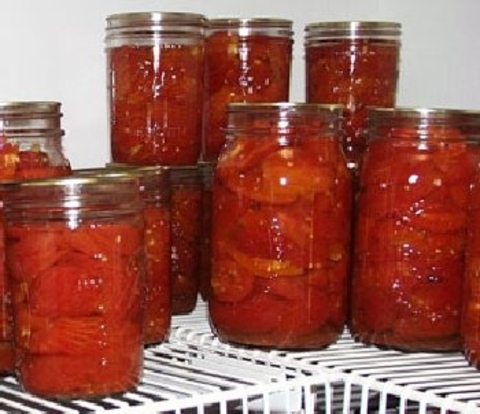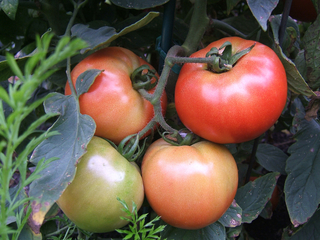Quick facts
To find reliable and safe salsa and other tomato canning recipes:
-
Use resources from USDA, National Center for Home Food Preservation and university websites for safe canning recipes and techniques.
-
To search for government and university sources specifically, use "site:.gov" or "site:.edu" in your search terms. For example: “canning salsa site:.edu”.
-
Don’t use recipes from blogs and sites that use short cuts or original untested recipes, or that change or alter research tested recipes.
Home canning tomatoes is a great way to preserve them for later use. Proper methods, choice ingredients and awareness of acidity levels are critical to a safe home-canned product.
Choose a newer recipe and follow directions
Directions and processing times for tomatoes and tomato products were re-evaluated for safety in the late 1980s. The updated directions were published in 1994 in the USDA Complete Guide to Home Canning. For safety sake, be sure to use a research tested recipe dated 1994 or newer. Select a recipe for the tomato product you are canning and follow all instructions exactly.
The National Center for Home Food Preservation Canning Tomatoes and Tomato Products lists over 15 options for home-canning tomatoes. Each recipe has specific directions on preparing the tomatoes, filling the jars and processing time.
Choose only high-quality tomatoes
Choose fresh, vine-ripened tomatoes that are at their peak ripeness. Over-ripe tomatoes are less acidic. The acidity level in tomatoes varies throughout the growing season. Tomatoes reach their highest acidity when they are still green and decrease in acidity until they reach their lowest acidity as they mature.
Do not can damaged tomatoes or those from dead or frost-killed vines. These tomatoes may have harmful pathogens. The canning process time may not be enough to kill disease organisms. This could lead to a product that spoils and is unsafe to eat.
Add acid to all tomatoes before processing
A high acid level (pH of 4.6 or less) prevents the growth of Clostridium botulinum bacteria which causes botulism. Because many factors impact the acidity level of tomatoes, USDA recommends adding acid to all home-canned tomatoes and tomato products.
Treat heirloom tomato varieties the same as any other tomato. The acidity of heirloom tomatoes is no different from the non-heirloom varieties. Some heirloom varieties are more low-acid than hybrid varieties. Therefore, the same acidification recommendations apply for canning heirloom tomatoes.
Factors that affect acidity level
The acidity level of tomatoes can be affected by many factors, including:
- The variety of tomato.
- Stressful growing conditions.
- Over-mature fruit.
Also, the acidity level of canned tomato products can be affected by:
- Adding low-acid ingredients to tomatoes (such as onion and peppers).
- Making juice versus tomato solids.
- The canning process itself.
Citric acid, lemon juice or vinegar are good choices for added acid
Citric acid
Citric acid is available wherever canning supplies are sold. Canning supply companies like Mrs. Wages® and Ball® have a powder form of citric acid. Some health food stores carry citric acid and you can order it online. Be sure the product you buy is food grade.
Lemon juice
Use commercially bottled juice. Don't use freshly squeezed lemon juice because the acidity level varies and there is a chance of contaminating the juice from the rind. You can safely use bottled lime juice instead of bottled lemon juice.
Bottled lemon and lime juice contain sulfites. If you or family members have a sulfite sensitivity or allergy, use citric acid, vinegar or frozen lemon juice (not lemonade) from the grocery store (not homemade). Use the same amounts of frozen juice as bottled lemon juice.
Vinegar
All vinegars will noticeably change the flavor of your end product. You can add a small amount of sugar to help offset the flavor.
Do not use tomato canning tablets; they are ineffective.
Add acid to all tomatoes when canning
| Acid | Effect | Amount |
|---|---|---|
| Citric acid | Little change in flavor | 1/2 teaspoon per quart; 1/4 teaspoon per pint |
| Bottled lemon juice | Easy to use | 2 tablespoons per quart; 1 tablespoon per pint |
| Vinegar (5% acidity) | Noticeable flavor change | 4 tablespoons per quart; 2 tablespoons per pint |
Process for the correct amount of time
- Processing times are based on the type of liquid used to pack or fill the jar of tomatoes.
- Tomatoes with no added liquid or packed in tomato juice have longer processing times because the heat distribution is less effective in juice than in water.
- Remember to adjust for Minnesota altitudes, choose processing times for 1001-2000 feet.
- Processing times found on this website are adjusted for Minnesota altitudes.
Minnesota home canning processing chart for tomatoes
| Type of food | Style of pack | Jar size | Head space | Boiling water bath | Pressure canner | Dial gauge | Weighted gauge |
|---|---|---|---|---|---|---|---|
| Tomatoes* (no added liquid) | Raw | Pints and quarts | ½ inch | 90 minutes | 25 minutes | 11# | 15# |
| Tomatoes* (packed in water) | Hot and raw | Pints | ½ inch | 45 minutes | 10 minutes | 11# | 15# |
| Tomatoes* (packed in water) | Hot and raw | Quarts | ½ inch | 50 minutes | 10 minutes | 11# | 15# |
| Tomatoes* (packed in juice) | Hot and raw | Pints and quarts | ½ inch | 90 minutes | 25 minutes | 11# | 15# |
| Tomato Juice* | Hot | Pints | ½ inch | 40 minutes | 15 minutes | 11# | 15# |
| Tomato Juice* | Hot | Quarts | ½ inch | 45 minutes | 15 minutes | 11# | 15# |
Never add thickener before canning tomato products
Every year, home food preservers want to know how to thicken salsa or tomato soup with flour, cornstarch, rice, pasta or cream before canning. Never, under any circumstances, add a thickening product before canning.
Thickening products will change the acidity level of your tomatoes. They can create a thick product that does not allow good heat penetration. As a result, adding thickeners before canning may result in an unsafe product.
To produce a thicker tomato product:
- Try using Italian plum-style or paste tomatoes vs. large slicing tomatoes.
- Thicken salsas by adding tomato paste or by draining off some of the liquid after you chop the tomatoes.
Thicken just before serving
Thicken tomato products with flour, cream, cornstarch, etc. just before serving. If you do thicken your tomato soup mixture, it can be frozen successfully but never canned.
- National Center for Home Food Preservation. Canning tomatoes and tomato products.
- National Center for Home Food Preservation. Andress. E. (2010). Sorting out tomato canning directions.
-
Savoie, K.; Perry, J. Adherence of food blogs salsa recipes to home canning guidelines. J. Food Protection Trends, September/October 2019, Vol 39, No. 5, p. 377–386. International Association for Food Protection. The University of Maine of evaluated 56 home canning salsa recipes from 43 blogs. They found that 70% of the recipes did not include USDA food safety home canning standards. Only five recipes (9%) had the ratio of added acid (vinegar) to vegetables used. Only 4 (7%) of the 56 recipes provided correct processing time, how to adjust for altitude and when to start monitoring processing time.
-
Study finds online salsa recipes for home canning lacking food safety standards. August 28, 2019. University of Maine News.
Reviewed in 2019




